Organizational Behavior Theories in Practice: Myers, Australia Case
VerifiedAdded on 2023/06/11
|16
|4468
|481
Case Study
AI Summary
This case study delves into the organizational behavior of Myers, Australia, examining the application of various motivation theories such as Herzberg's Two-Factor Theory, Maslow's Hierarchy of Needs, Vroom's Expectancy Theory, and McClelland's Need Theory. It explores how Myers utilizes these theories to understand and address employee needs, enhance motivation, and improve overall performance. The analysis covers aspects like creating a safe working environment, providing training, involving employees in goal setting, and fostering a culture of recognition and career development. A critical approach is taken to assess the effectiveness and limitations of these motivational theories in the context of Myers' specific workplace dynamics, highlighting both successes and areas for improvement in their application.
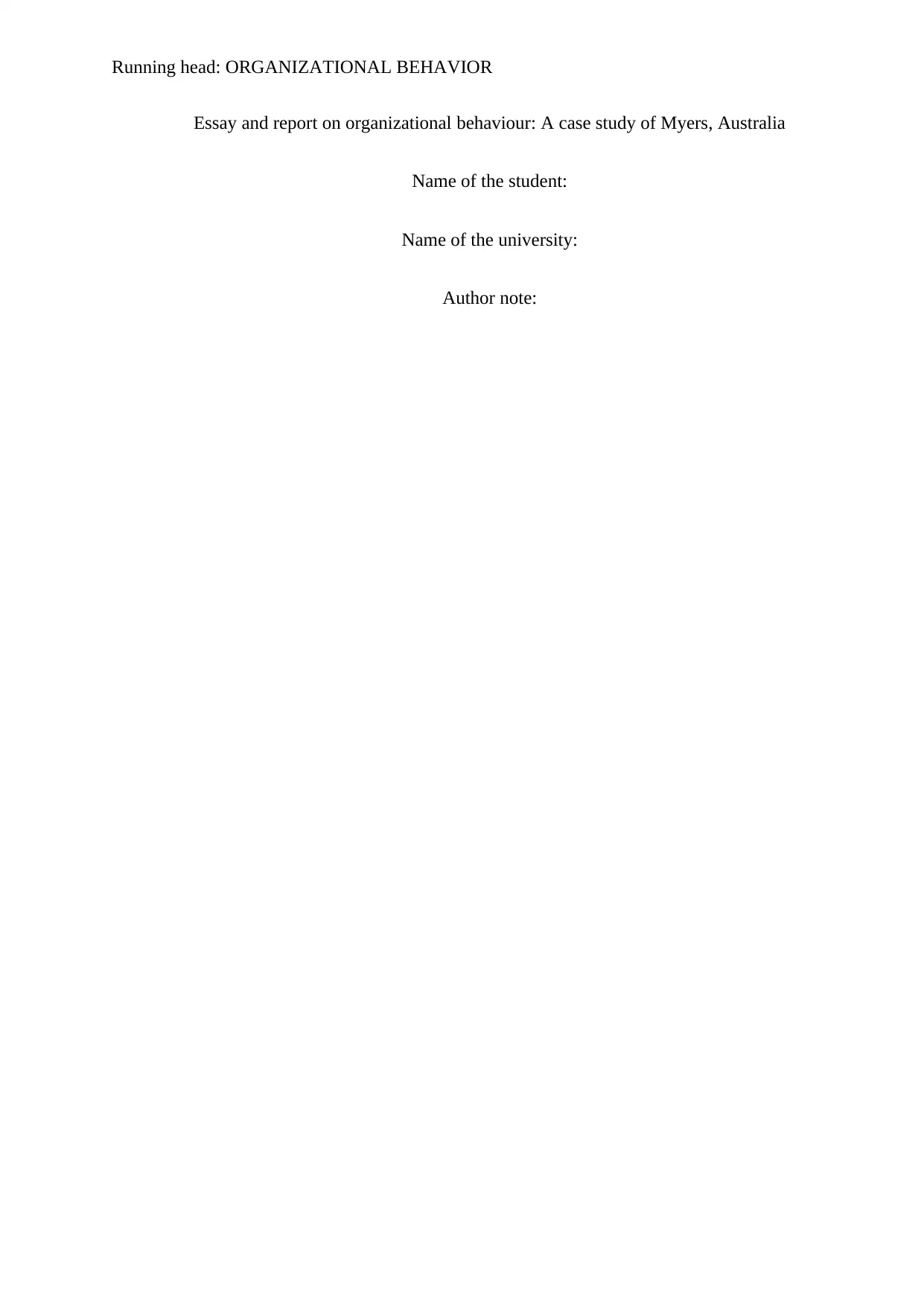
Running head: ORGANIZATIONAL BEHAVIOR
Essay and report on organizational behaviour: A case study of Myers, Australia
Name of the student:
Name of the university:
Author note:
Essay and report on organizational behaviour: A case study of Myers, Australia
Name of the student:
Name of the university:
Author note:
Paraphrase This Document
Need a fresh take? Get an instant paraphrase of this document with our AI Paraphraser
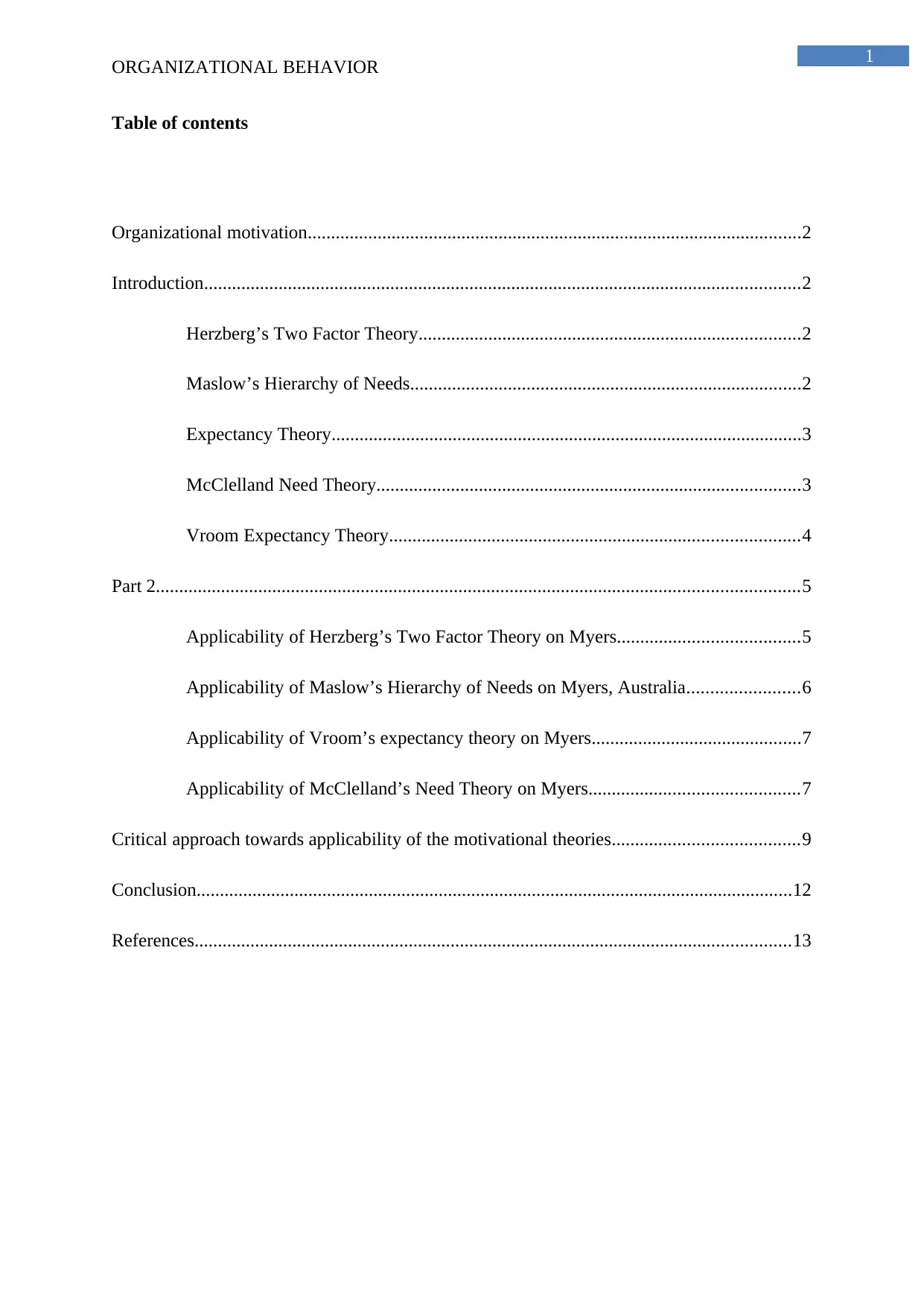
1
ORGANIZATIONAL BEHAVIOR
Table of contents
Organizational motivation..........................................................................................................2
Introduction................................................................................................................................2
Herzberg’s Two Factor Theory..................................................................................2
Maslow’s Hierarchy of Needs....................................................................................2
Expectancy Theory.....................................................................................................3
McClelland Need Theory...........................................................................................3
Vroom Expectancy Theory........................................................................................4
Part 2..........................................................................................................................................5
Applicability of Herzberg’s Two Factor Theory on Myers.......................................5
Applicability of Maslow’s Hierarchy of Needs on Myers, Australia........................6
Applicability of Vroom’s expectancy theory on Myers.............................................7
Applicability of McClelland’s Need Theory on Myers.............................................7
Critical approach towards applicability of the motivational theories........................................9
Conclusion................................................................................................................................12
References................................................................................................................................13
ORGANIZATIONAL BEHAVIOR
Table of contents
Organizational motivation..........................................................................................................2
Introduction................................................................................................................................2
Herzberg’s Two Factor Theory..................................................................................2
Maslow’s Hierarchy of Needs....................................................................................2
Expectancy Theory.....................................................................................................3
McClelland Need Theory...........................................................................................3
Vroom Expectancy Theory........................................................................................4
Part 2..........................................................................................................................................5
Applicability of Herzberg’s Two Factor Theory on Myers.......................................5
Applicability of Maslow’s Hierarchy of Needs on Myers, Australia........................6
Applicability of Vroom’s expectancy theory on Myers.............................................7
Applicability of McClelland’s Need Theory on Myers.............................................7
Critical approach towards applicability of the motivational theories........................................9
Conclusion................................................................................................................................12
References................................................................................................................................13
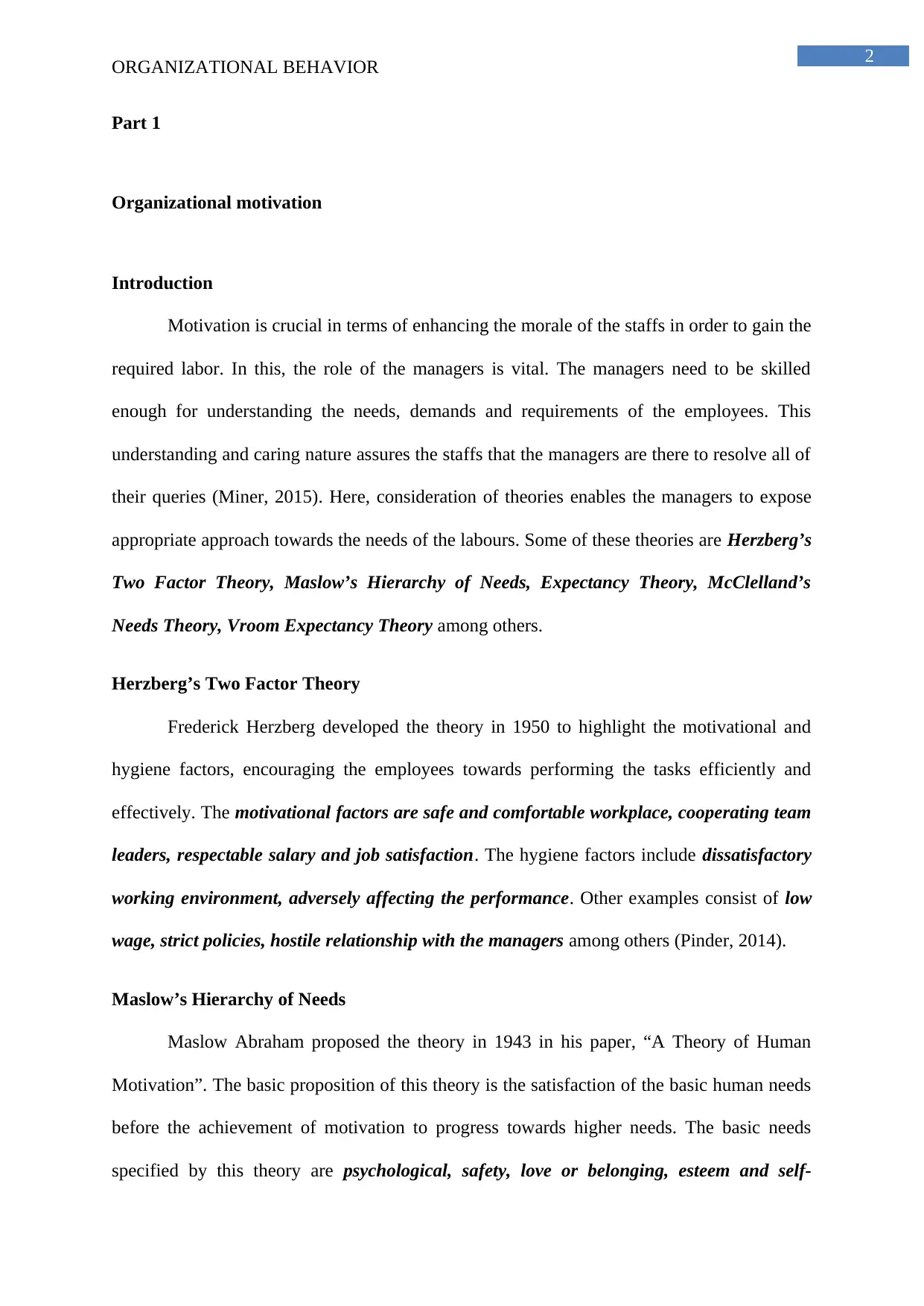
2
ORGANIZATIONAL BEHAVIOR
Part 1
Organizational motivation
Introduction
Motivation is crucial in terms of enhancing the morale of the staffs in order to gain the
required labor. In this, the role of the managers is vital. The managers need to be skilled
enough for understanding the needs, demands and requirements of the employees. This
understanding and caring nature assures the staffs that the managers are there to resolve all of
their queries (Miner, 2015). Here, consideration of theories enables the managers to expose
appropriate approach towards the needs of the labours. Some of these theories are Herzberg’s
Two Factor Theory, Maslow’s Hierarchy of Needs, Expectancy Theory, McClelland’s
Needs Theory, Vroom Expectancy Theory among others.
Herzberg’s Two Factor Theory
Frederick Herzberg developed the theory in 1950 to highlight the motivational and
hygiene factors, encouraging the employees towards performing the tasks efficiently and
effectively. The motivational factors are safe and comfortable workplace, cooperating team
leaders, respectable salary and job satisfaction. The hygiene factors include dissatisfactory
working environment, adversely affecting the performance. Other examples consist of low
wage, strict policies, hostile relationship with the managers among others (Pinder, 2014).
Maslow’s Hierarchy of Needs
Maslow Abraham proposed the theory in 1943 in his paper, “A Theory of Human
Motivation”. The basic proposition of this theory is the satisfaction of the basic human needs
before the achievement of motivation to progress towards higher needs. The basic needs
specified by this theory are psychological, safety, love or belonging, esteem and self-
ORGANIZATIONAL BEHAVIOR
Part 1
Organizational motivation
Introduction
Motivation is crucial in terms of enhancing the morale of the staffs in order to gain the
required labor. In this, the role of the managers is vital. The managers need to be skilled
enough for understanding the needs, demands and requirements of the employees. This
understanding and caring nature assures the staffs that the managers are there to resolve all of
their queries (Miner, 2015). Here, consideration of theories enables the managers to expose
appropriate approach towards the needs of the labours. Some of these theories are Herzberg’s
Two Factor Theory, Maslow’s Hierarchy of Needs, Expectancy Theory, McClelland’s
Needs Theory, Vroom Expectancy Theory among others.
Herzberg’s Two Factor Theory
Frederick Herzberg developed the theory in 1950 to highlight the motivational and
hygiene factors, encouraging the employees towards performing the tasks efficiently and
effectively. The motivational factors are safe and comfortable workplace, cooperating team
leaders, respectable salary and job satisfaction. The hygiene factors include dissatisfactory
working environment, adversely affecting the performance. Other examples consist of low
wage, strict policies, hostile relationship with the managers among others (Pinder, 2014).
Maslow’s Hierarchy of Needs
Maslow Abraham proposed the theory in 1943 in his paper, “A Theory of Human
Motivation”. The basic proposition of this theory is the satisfaction of the basic human needs
before the achievement of motivation to progress towards higher needs. The basic needs
specified by this theory are psychological, safety, love or belonging, esteem and self-
⊘ This is a preview!⊘
Do you want full access?
Subscribe today to unlock all pages.

Trusted by 1+ million students worldwide
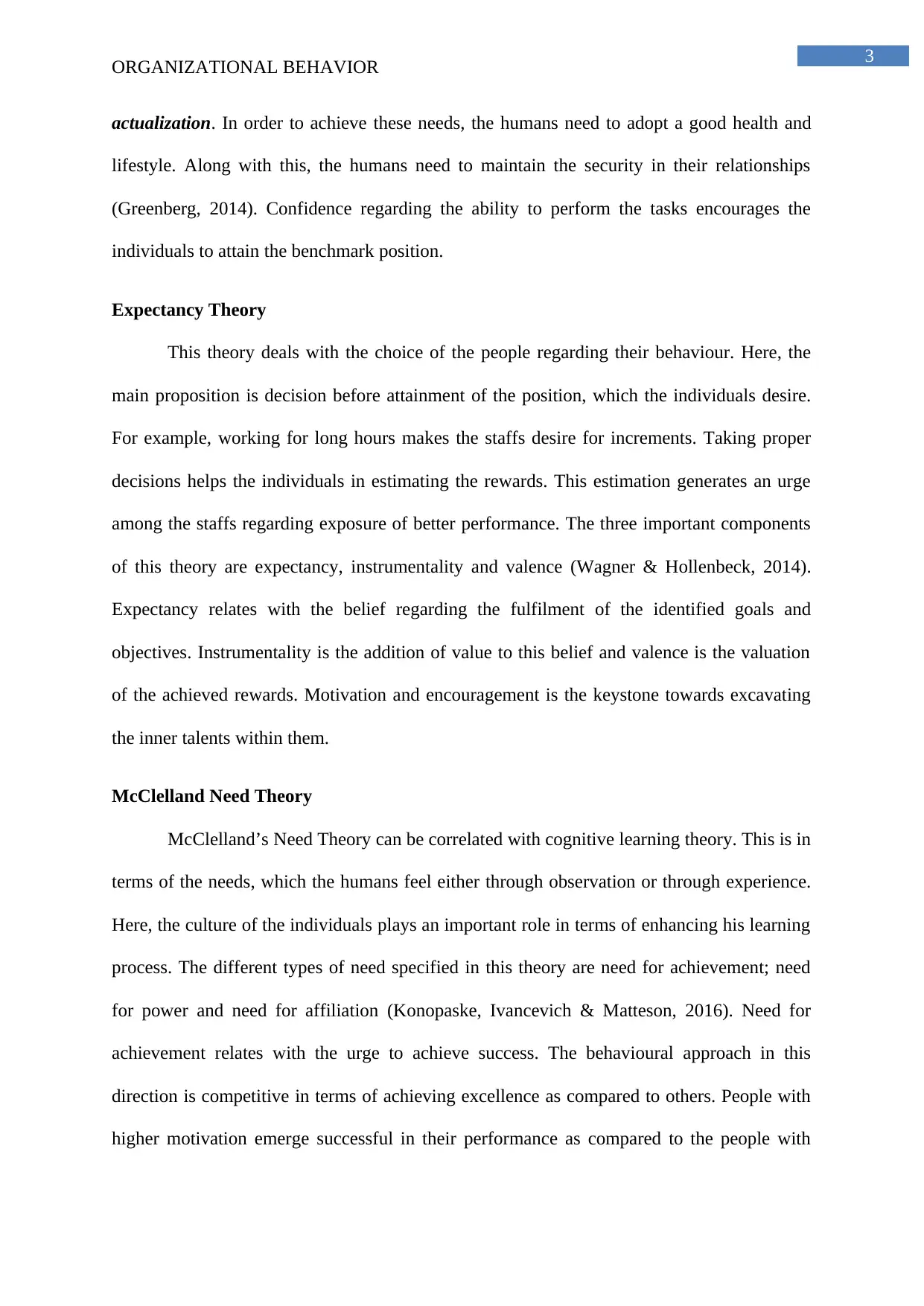
3
ORGANIZATIONAL BEHAVIOR
actualization. In order to achieve these needs, the humans need to adopt a good health and
lifestyle. Along with this, the humans need to maintain the security in their relationships
(Greenberg, 2014). Confidence regarding the ability to perform the tasks encourages the
individuals to attain the benchmark position.
Expectancy Theory
This theory deals with the choice of the people regarding their behaviour. Here, the
main proposition is decision before attainment of the position, which the individuals desire.
For example, working for long hours makes the staffs desire for increments. Taking proper
decisions helps the individuals in estimating the rewards. This estimation generates an urge
among the staffs regarding exposure of better performance. The three important components
of this theory are expectancy, instrumentality and valence (Wagner & Hollenbeck, 2014).
Expectancy relates with the belief regarding the fulfilment of the identified goals and
objectives. Instrumentality is the addition of value to this belief and valence is the valuation
of the achieved rewards. Motivation and encouragement is the keystone towards excavating
the inner talents within them.
McClelland Need Theory
McClelland’s Need Theory can be correlated with cognitive learning theory. This is in
terms of the needs, which the humans feel either through observation or through experience.
Here, the culture of the individuals plays an important role in terms of enhancing his learning
process. The different types of need specified in this theory are need for achievement; need
for power and need for affiliation (Konopaske, Ivancevich & Matteson, 2016). Need for
achievement relates with the urge to achieve success. The behavioural approach in this
direction is competitive in terms of achieving excellence as compared to others. People with
higher motivation emerge successful in their performance as compared to the people with
ORGANIZATIONAL BEHAVIOR
actualization. In order to achieve these needs, the humans need to adopt a good health and
lifestyle. Along with this, the humans need to maintain the security in their relationships
(Greenberg, 2014). Confidence regarding the ability to perform the tasks encourages the
individuals to attain the benchmark position.
Expectancy Theory
This theory deals with the choice of the people regarding their behaviour. Here, the
main proposition is decision before attainment of the position, which the individuals desire.
For example, working for long hours makes the staffs desire for increments. Taking proper
decisions helps the individuals in estimating the rewards. This estimation generates an urge
among the staffs regarding exposure of better performance. The three important components
of this theory are expectancy, instrumentality and valence (Wagner & Hollenbeck, 2014).
Expectancy relates with the belief regarding the fulfilment of the identified goals and
objectives. Instrumentality is the addition of value to this belief and valence is the valuation
of the achieved rewards. Motivation and encouragement is the keystone towards excavating
the inner talents within them.
McClelland Need Theory
McClelland’s Need Theory can be correlated with cognitive learning theory. This is in
terms of the needs, which the humans feel either through observation or through experience.
Here, the culture of the individuals plays an important role in terms of enhancing his learning
process. The different types of need specified in this theory are need for achievement; need
for power and need for affiliation (Konopaske, Ivancevich & Matteson, 2016). Need for
achievement relates with the urge to achieve success. The behavioural approach in this
direction is competitive in terms of achieving excellence as compared to others. People with
higher motivation emerge successful in their performance as compared to the people with
Paraphrase This Document
Need a fresh take? Get an instant paraphrase of this document with our AI Paraphraser
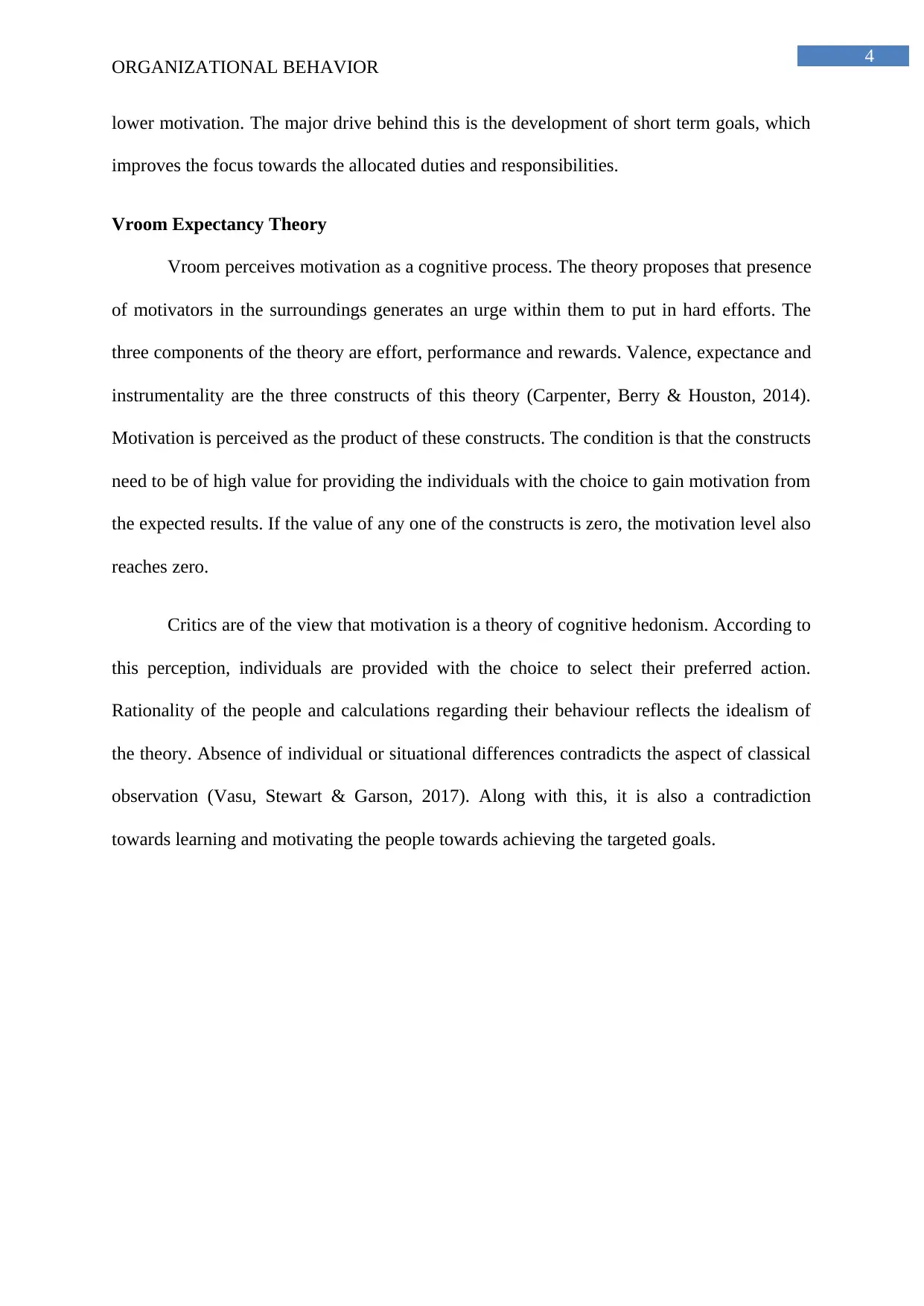
4
ORGANIZATIONAL BEHAVIOR
lower motivation. The major drive behind this is the development of short term goals, which
improves the focus towards the allocated duties and responsibilities.
Vroom Expectancy Theory
Vroom perceives motivation as a cognitive process. The theory proposes that presence
of motivators in the surroundings generates an urge within them to put in hard efforts. The
three components of the theory are effort, performance and rewards. Valence, expectance and
instrumentality are the three constructs of this theory (Carpenter, Berry & Houston, 2014).
Motivation is perceived as the product of these constructs. The condition is that the constructs
need to be of high value for providing the individuals with the choice to gain motivation from
the expected results. If the value of any one of the constructs is zero, the motivation level also
reaches zero.
Critics are of the view that motivation is a theory of cognitive hedonism. According to
this perception, individuals are provided with the choice to select their preferred action.
Rationality of the people and calculations regarding their behaviour reflects the idealism of
the theory. Absence of individual or situational differences contradicts the aspect of classical
observation (Vasu, Stewart & Garson, 2017). Along with this, it is also a contradiction
towards learning and motivating the people towards achieving the targeted goals.
ORGANIZATIONAL BEHAVIOR
lower motivation. The major drive behind this is the development of short term goals, which
improves the focus towards the allocated duties and responsibilities.
Vroom Expectancy Theory
Vroom perceives motivation as a cognitive process. The theory proposes that presence
of motivators in the surroundings generates an urge within them to put in hard efforts. The
three components of the theory are effort, performance and rewards. Valence, expectance and
instrumentality are the three constructs of this theory (Carpenter, Berry & Houston, 2014).
Motivation is perceived as the product of these constructs. The condition is that the constructs
need to be of high value for providing the individuals with the choice to gain motivation from
the expected results. If the value of any one of the constructs is zero, the motivation level also
reaches zero.
Critics are of the view that motivation is a theory of cognitive hedonism. According to
this perception, individuals are provided with the choice to select their preferred action.
Rationality of the people and calculations regarding their behaviour reflects the idealism of
the theory. Absence of individual or situational differences contradicts the aspect of classical
observation (Vasu, Stewart & Garson, 2017). Along with this, it is also a contradiction
towards learning and motivating the people towards achieving the targeted goals.
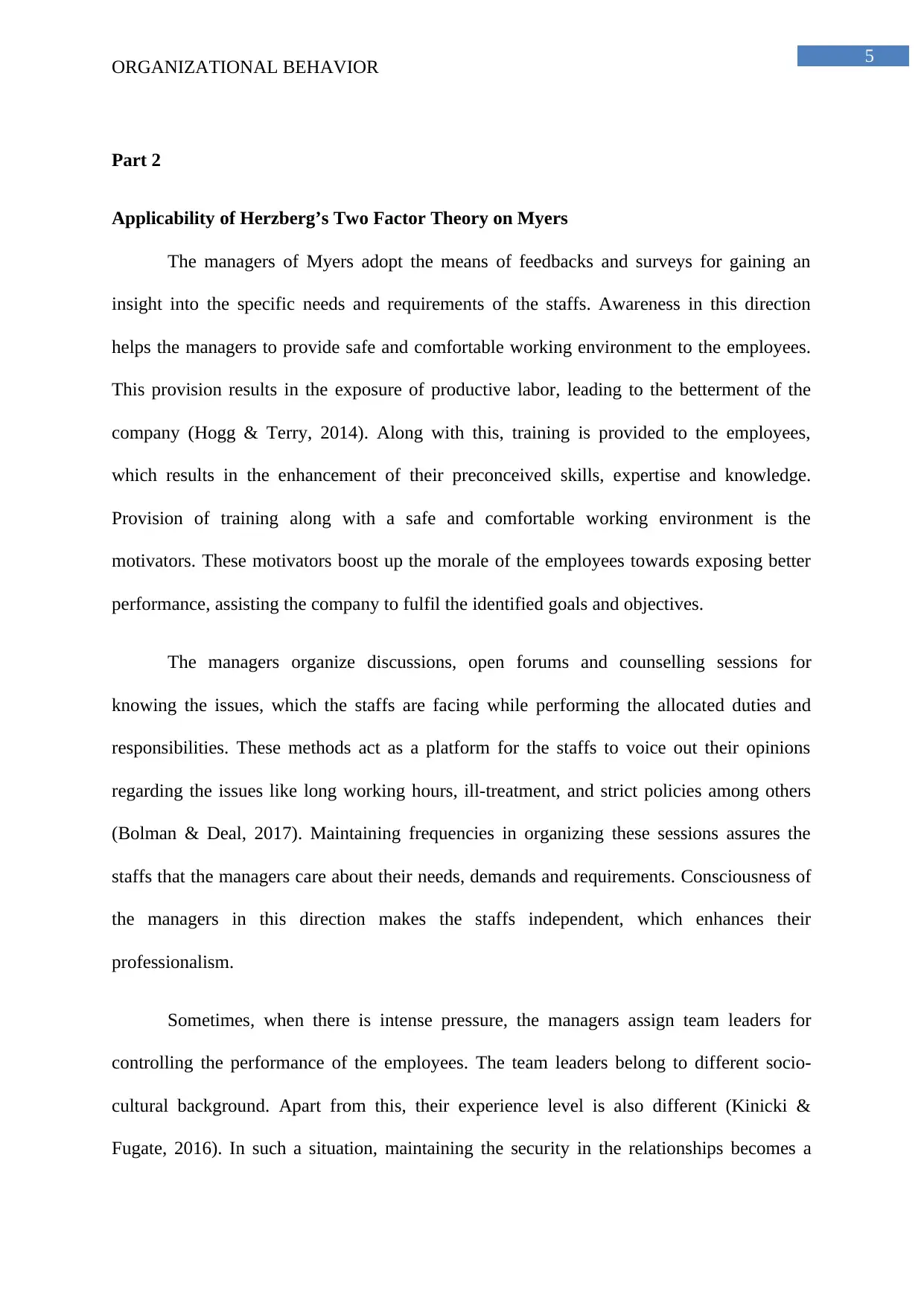
5
ORGANIZATIONAL BEHAVIOR
Part 2
Applicability of Herzberg’s Two Factor Theory on Myers
The managers of Myers adopt the means of feedbacks and surveys for gaining an
insight into the specific needs and requirements of the staffs. Awareness in this direction
helps the managers to provide safe and comfortable working environment to the employees.
This provision results in the exposure of productive labor, leading to the betterment of the
company (Hogg & Terry, 2014). Along with this, training is provided to the employees,
which results in the enhancement of their preconceived skills, expertise and knowledge.
Provision of training along with a safe and comfortable working environment is the
motivators. These motivators boost up the morale of the employees towards exposing better
performance, assisting the company to fulfil the identified goals and objectives.
The managers organize discussions, open forums and counselling sessions for
knowing the issues, which the staffs are facing while performing the allocated duties and
responsibilities. These methods act as a platform for the staffs to voice out their opinions
regarding the issues like long working hours, ill-treatment, and strict policies among others
(Bolman & Deal, 2017). Maintaining frequencies in organizing these sessions assures the
staffs that the managers care about their needs, demands and requirements. Consciousness of
the managers in this direction makes the staffs independent, which enhances their
professionalism.
Sometimes, when there is intense pressure, the managers assign team leaders for
controlling the performance of the employees. The team leaders belong to different socio-
cultural background. Apart from this, their experience level is also different (Kinicki &
Fugate, 2016). In such a situation, maintaining the security in the relationships becomes a
ORGANIZATIONAL BEHAVIOR
Part 2
Applicability of Herzberg’s Two Factor Theory on Myers
The managers of Myers adopt the means of feedbacks and surveys for gaining an
insight into the specific needs and requirements of the staffs. Awareness in this direction
helps the managers to provide safe and comfortable working environment to the employees.
This provision results in the exposure of productive labor, leading to the betterment of the
company (Hogg & Terry, 2014). Along with this, training is provided to the employees,
which results in the enhancement of their preconceived skills, expertise and knowledge.
Provision of training along with a safe and comfortable working environment is the
motivators. These motivators boost up the morale of the employees towards exposing better
performance, assisting the company to fulfil the identified goals and objectives.
The managers organize discussions, open forums and counselling sessions for
knowing the issues, which the staffs are facing while performing the allocated duties and
responsibilities. These methods act as a platform for the staffs to voice out their opinions
regarding the issues like long working hours, ill-treatment, and strict policies among others
(Bolman & Deal, 2017). Maintaining frequencies in organizing these sessions assures the
staffs that the managers care about their needs, demands and requirements. Consciousness of
the managers in this direction makes the staffs independent, which enhances their
professionalism.
Sometimes, when there is intense pressure, the managers assign team leaders for
controlling the performance of the employees. The team leaders belong to different socio-
cultural background. Apart from this, their experience level is also different (Kinicki &
Fugate, 2016). In such a situation, maintaining the security in the relationships becomes a
⊘ This is a preview!⊘
Do you want full access?
Subscribe today to unlock all pages.

Trusted by 1+ million students worldwide
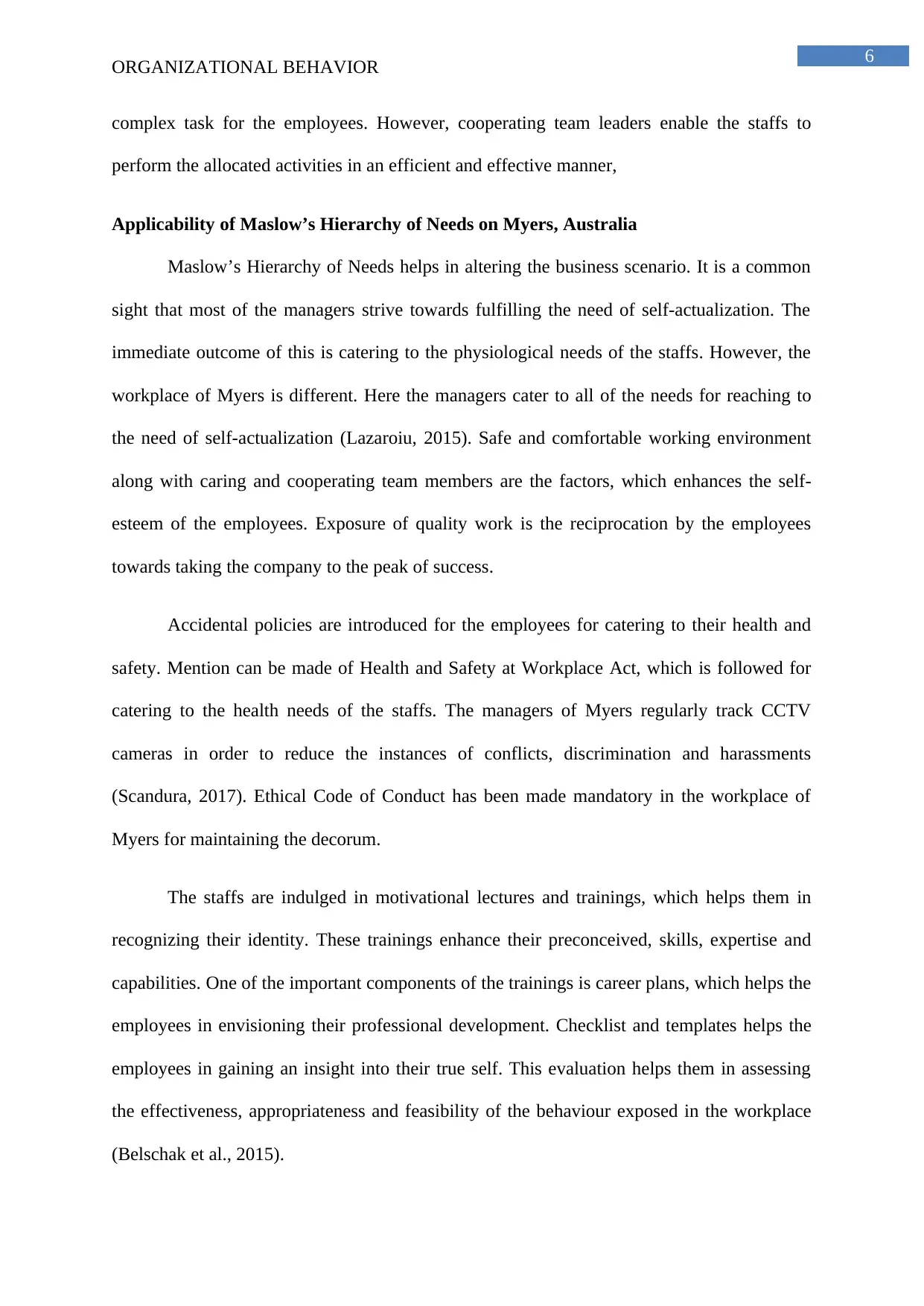
6
ORGANIZATIONAL BEHAVIOR
complex task for the employees. However, cooperating team leaders enable the staffs to
perform the allocated activities in an efficient and effective manner,
Applicability of Maslow’s Hierarchy of Needs on Myers, Australia
Maslow’s Hierarchy of Needs helps in altering the business scenario. It is a common
sight that most of the managers strive towards fulfilling the need of self-actualization. The
immediate outcome of this is catering to the physiological needs of the staffs. However, the
workplace of Myers is different. Here the managers cater to all of the needs for reaching to
the need of self-actualization (Lazaroiu, 2015). Safe and comfortable working environment
along with caring and cooperating team members are the factors, which enhances the self-
esteem of the employees. Exposure of quality work is the reciprocation by the employees
towards taking the company to the peak of success.
Accidental policies are introduced for the employees for catering to their health and
safety. Mention can be made of Health and Safety at Workplace Act, which is followed for
catering to the health needs of the staffs. The managers of Myers regularly track CCTV
cameras in order to reduce the instances of conflicts, discrimination and harassments
(Scandura, 2017). Ethical Code of Conduct has been made mandatory in the workplace of
Myers for maintaining the decorum.
The staffs are indulged in motivational lectures and trainings, which helps them in
recognizing their identity. These trainings enhance their preconceived, skills, expertise and
capabilities. One of the important components of the trainings is career plans, which helps the
employees in envisioning their professional development. Checklist and templates helps the
employees in gaining an insight into their true self. This evaluation helps them in assessing
the effectiveness, appropriateness and feasibility of the behaviour exposed in the workplace
(Belschak et al., 2015).
ORGANIZATIONAL BEHAVIOR
complex task for the employees. However, cooperating team leaders enable the staffs to
perform the allocated activities in an efficient and effective manner,
Applicability of Maslow’s Hierarchy of Needs on Myers, Australia
Maslow’s Hierarchy of Needs helps in altering the business scenario. It is a common
sight that most of the managers strive towards fulfilling the need of self-actualization. The
immediate outcome of this is catering to the physiological needs of the staffs. However, the
workplace of Myers is different. Here the managers cater to all of the needs for reaching to
the need of self-actualization (Lazaroiu, 2015). Safe and comfortable working environment
along with caring and cooperating team members are the factors, which enhances the self-
esteem of the employees. Exposure of quality work is the reciprocation by the employees
towards taking the company to the peak of success.
Accidental policies are introduced for the employees for catering to their health and
safety. Mention can be made of Health and Safety at Workplace Act, which is followed for
catering to the health needs of the staffs. The managers of Myers regularly track CCTV
cameras in order to reduce the instances of conflicts, discrimination and harassments
(Scandura, 2017). Ethical Code of Conduct has been made mandatory in the workplace of
Myers for maintaining the decorum.
The staffs are indulged in motivational lectures and trainings, which helps them in
recognizing their identity. These trainings enhance their preconceived, skills, expertise and
capabilities. One of the important components of the trainings is career plans, which helps the
employees in envisioning their professional development. Checklist and templates helps the
employees in gaining an insight into their true self. This evaluation helps them in assessing
the effectiveness, appropriateness and feasibility of the behaviour exposed in the workplace
(Belschak et al., 2015).
Paraphrase This Document
Need a fresh take? Get an instant paraphrase of this document with our AI Paraphraser
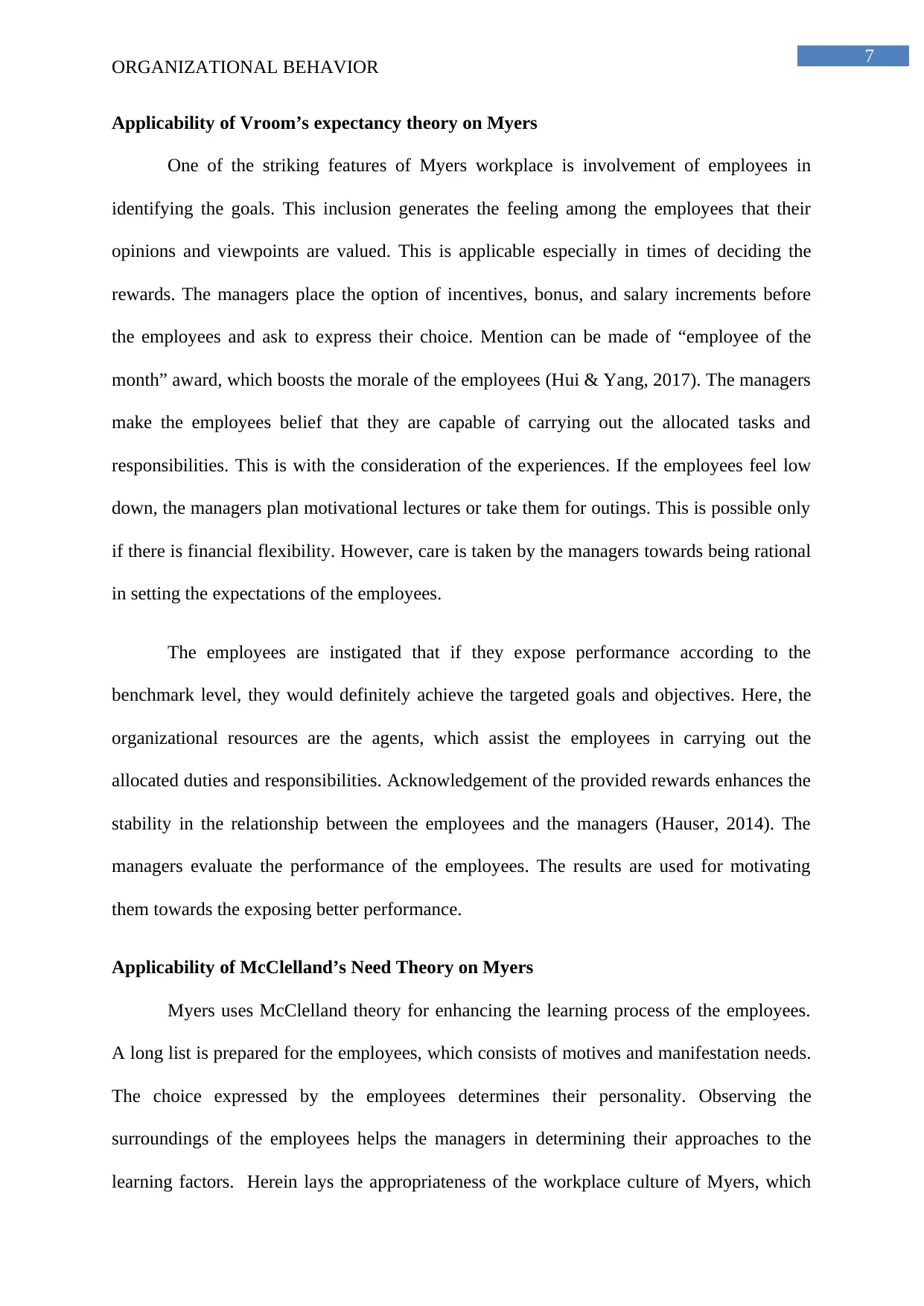
7
ORGANIZATIONAL BEHAVIOR
Applicability of Vroom’s expectancy theory on Myers
One of the striking features of Myers workplace is involvement of employees in
identifying the goals. This inclusion generates the feeling among the employees that their
opinions and viewpoints are valued. This is applicable especially in times of deciding the
rewards. The managers place the option of incentives, bonus, and salary increments before
the employees and ask to express their choice. Mention can be made of “employee of the
month” award, which boosts the morale of the employees (Hui & Yang, 2017). The managers
make the employees belief that they are capable of carrying out the allocated tasks and
responsibilities. This is with the consideration of the experiences. If the employees feel low
down, the managers plan motivational lectures or take them for outings. This is possible only
if there is financial flexibility. However, care is taken by the managers towards being rational
in setting the expectations of the employees.
The employees are instigated that if they expose performance according to the
benchmark level, they would definitely achieve the targeted goals and objectives. Here, the
organizational resources are the agents, which assist the employees in carrying out the
allocated duties and responsibilities. Acknowledgement of the provided rewards enhances the
stability in the relationship between the employees and the managers (Hauser, 2014). The
managers evaluate the performance of the employees. The results are used for motivating
them towards the exposing better performance.
Applicability of McClelland’s Need Theory on Myers
Myers uses McClelland theory for enhancing the learning process of the employees.
A long list is prepared for the employees, which consists of motives and manifestation needs.
The choice expressed by the employees determines their personality. Observing the
surroundings of the employees helps the managers in determining their approaches to the
learning factors. Herein lays the appropriateness of the workplace culture of Myers, which
ORGANIZATIONAL BEHAVIOR
Applicability of Vroom’s expectancy theory on Myers
One of the striking features of Myers workplace is involvement of employees in
identifying the goals. This inclusion generates the feeling among the employees that their
opinions and viewpoints are valued. This is applicable especially in times of deciding the
rewards. The managers place the option of incentives, bonus, and salary increments before
the employees and ask to express their choice. Mention can be made of “employee of the
month” award, which boosts the morale of the employees (Hui & Yang, 2017). The managers
make the employees belief that they are capable of carrying out the allocated tasks and
responsibilities. This is with the consideration of the experiences. If the employees feel low
down, the managers plan motivational lectures or take them for outings. This is possible only
if there is financial flexibility. However, care is taken by the managers towards being rational
in setting the expectations of the employees.
The employees are instigated that if they expose performance according to the
benchmark level, they would definitely achieve the targeted goals and objectives. Here, the
organizational resources are the agents, which assist the employees in carrying out the
allocated duties and responsibilities. Acknowledgement of the provided rewards enhances the
stability in the relationship between the employees and the managers (Hauser, 2014). The
managers evaluate the performance of the employees. The results are used for motivating
them towards the exposing better performance.
Applicability of McClelland’s Need Theory on Myers
Myers uses McClelland theory for enhancing the learning process of the employees.
A long list is prepared for the employees, which consists of motives and manifestation needs.
The choice expressed by the employees determines their personality. Observing the
surroundings of the employees helps the managers in determining their approaches to the
learning factors. Herein lays the appropriateness of the workplace culture of Myers, which
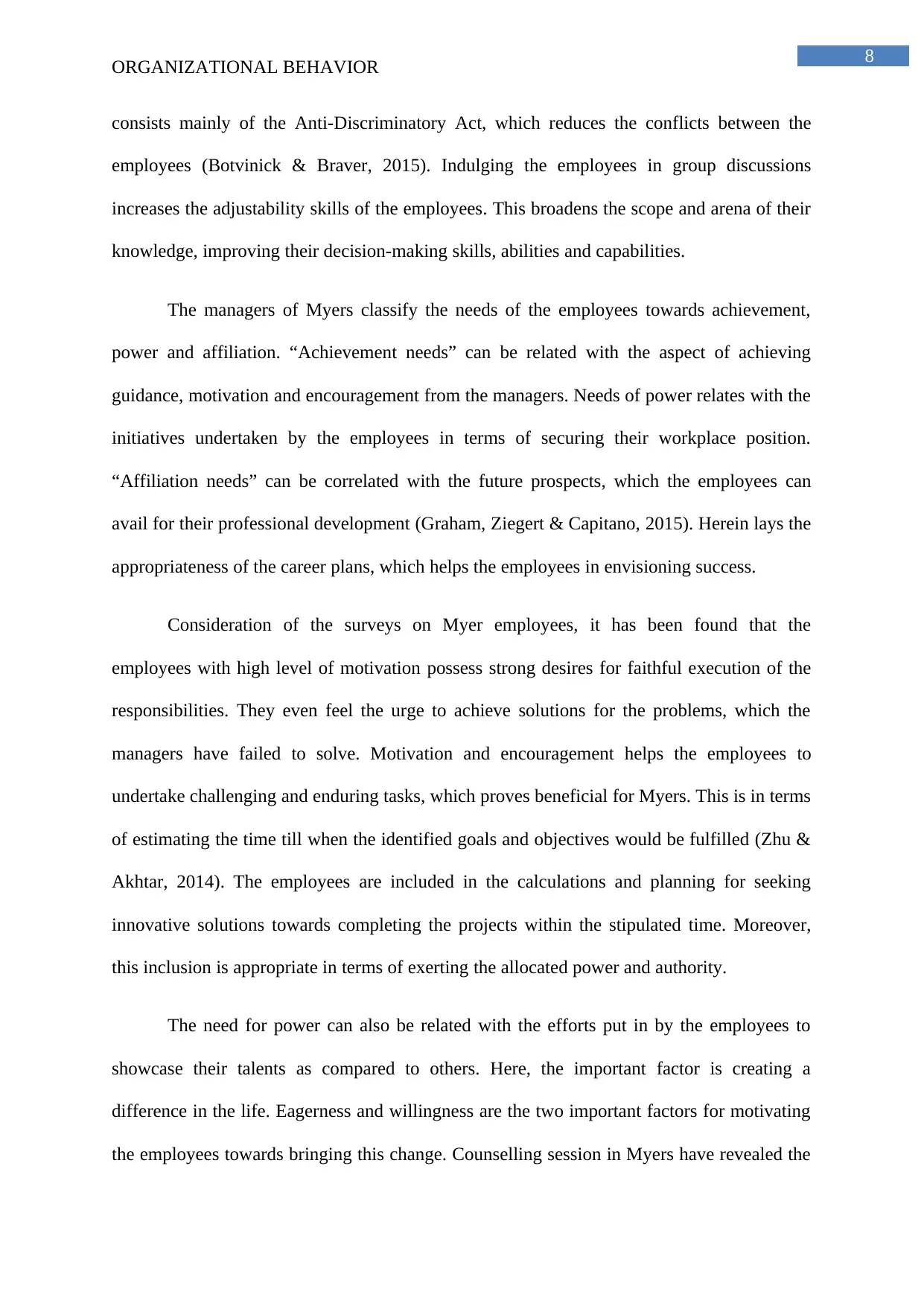
8
ORGANIZATIONAL BEHAVIOR
consists mainly of the Anti-Discriminatory Act, which reduces the conflicts between the
employees (Botvinick & Braver, 2015). Indulging the employees in group discussions
increases the adjustability skills of the employees. This broadens the scope and arena of their
knowledge, improving their decision-making skills, abilities and capabilities.
The managers of Myers classify the needs of the employees towards achievement,
power and affiliation. “Achievement needs” can be related with the aspect of achieving
guidance, motivation and encouragement from the managers. Needs of power relates with the
initiatives undertaken by the employees in terms of securing their workplace position.
“Affiliation needs” can be correlated with the future prospects, which the employees can
avail for their professional development (Graham, Ziegert & Capitano, 2015). Herein lays the
appropriateness of the career plans, which helps the employees in envisioning success.
Consideration of the surveys on Myer employees, it has been found that the
employees with high level of motivation possess strong desires for faithful execution of the
responsibilities. They even feel the urge to achieve solutions for the problems, which the
managers have failed to solve. Motivation and encouragement helps the employees to
undertake challenging and enduring tasks, which proves beneficial for Myers. This is in terms
of estimating the time till when the identified goals and objectives would be fulfilled (Zhu &
Akhtar, 2014). The employees are included in the calculations and planning for seeking
innovative solutions towards completing the projects within the stipulated time. Moreover,
this inclusion is appropriate in terms of exerting the allocated power and authority.
The need for power can also be related with the efforts put in by the employees to
showcase their talents as compared to others. Here, the important factor is creating a
difference in the life. Eagerness and willingness are the two important factors for motivating
the employees towards bringing this change. Counselling session in Myers have revealed the
ORGANIZATIONAL BEHAVIOR
consists mainly of the Anti-Discriminatory Act, which reduces the conflicts between the
employees (Botvinick & Braver, 2015). Indulging the employees in group discussions
increases the adjustability skills of the employees. This broadens the scope and arena of their
knowledge, improving their decision-making skills, abilities and capabilities.
The managers of Myers classify the needs of the employees towards achievement,
power and affiliation. “Achievement needs” can be related with the aspect of achieving
guidance, motivation and encouragement from the managers. Needs of power relates with the
initiatives undertaken by the employees in terms of securing their workplace position.
“Affiliation needs” can be correlated with the future prospects, which the employees can
avail for their professional development (Graham, Ziegert & Capitano, 2015). Herein lays the
appropriateness of the career plans, which helps the employees in envisioning success.
Consideration of the surveys on Myer employees, it has been found that the
employees with high level of motivation possess strong desires for faithful execution of the
responsibilities. They even feel the urge to achieve solutions for the problems, which the
managers have failed to solve. Motivation and encouragement helps the employees to
undertake challenging and enduring tasks, which proves beneficial for Myers. This is in terms
of estimating the time till when the identified goals and objectives would be fulfilled (Zhu &
Akhtar, 2014). The employees are included in the calculations and planning for seeking
innovative solutions towards completing the projects within the stipulated time. Moreover,
this inclusion is appropriate in terms of exerting the allocated power and authority.
The need for power can also be related with the efforts put in by the employees to
showcase their talents as compared to others. Here, the important factor is creating a
difference in the life. Eagerness and willingness are the two important factors for motivating
the employees towards bringing this change. Counselling session in Myers have revealed the
⊘ This is a preview!⊘
Do you want full access?
Subscribe today to unlock all pages.

Trusted by 1+ million students worldwide
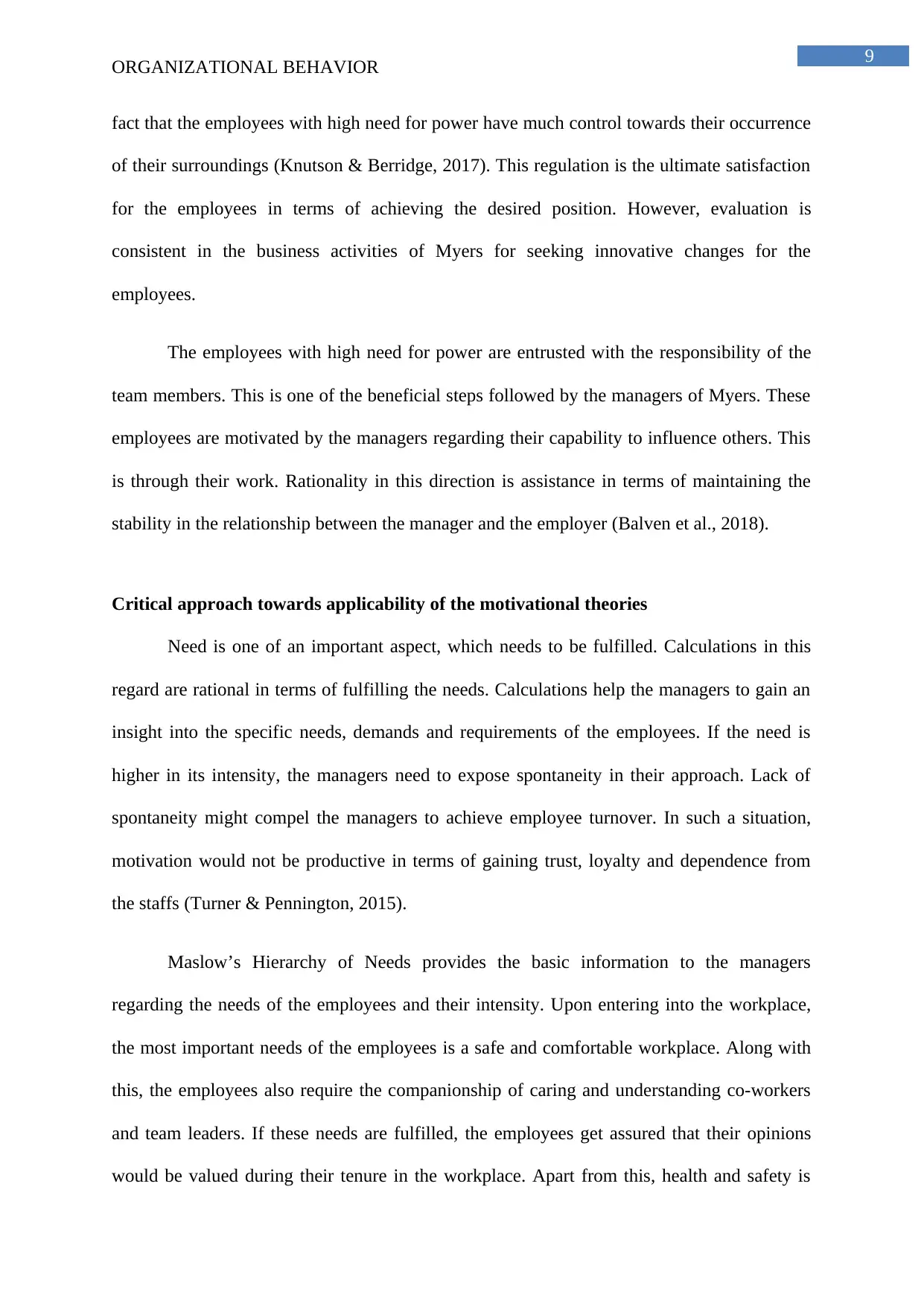
9
ORGANIZATIONAL BEHAVIOR
fact that the employees with high need for power have much control towards their occurrence
of their surroundings (Knutson & Berridge, 2017). This regulation is the ultimate satisfaction
for the employees in terms of achieving the desired position. However, evaluation is
consistent in the business activities of Myers for seeking innovative changes for the
employees.
The employees with high need for power are entrusted with the responsibility of the
team members. This is one of the beneficial steps followed by the managers of Myers. These
employees are motivated by the managers regarding their capability to influence others. This
is through their work. Rationality in this direction is assistance in terms of maintaining the
stability in the relationship between the manager and the employer (Balven et al., 2018).
Critical approach towards applicability of the motivational theories
Need is one of an important aspect, which needs to be fulfilled. Calculations in this
regard are rational in terms of fulfilling the needs. Calculations help the managers to gain an
insight into the specific needs, demands and requirements of the employees. If the need is
higher in its intensity, the managers need to expose spontaneity in their approach. Lack of
spontaneity might compel the managers to achieve employee turnover. In such a situation,
motivation would not be productive in terms of gaining trust, loyalty and dependence from
the staffs (Turner & Pennington, 2015).
Maslow’s Hierarchy of Needs provides the basic information to the managers
regarding the needs of the employees and their intensity. Upon entering into the workplace,
the most important needs of the employees is a safe and comfortable workplace. Along with
this, the employees also require the companionship of caring and understanding co-workers
and team leaders. If these needs are fulfilled, the employees get assured that their opinions
would be valued during their tenure in the workplace. Apart from this, health and safety is
ORGANIZATIONAL BEHAVIOR
fact that the employees with high need for power have much control towards their occurrence
of their surroundings (Knutson & Berridge, 2017). This regulation is the ultimate satisfaction
for the employees in terms of achieving the desired position. However, evaluation is
consistent in the business activities of Myers for seeking innovative changes for the
employees.
The employees with high need for power are entrusted with the responsibility of the
team members. This is one of the beneficial steps followed by the managers of Myers. These
employees are motivated by the managers regarding their capability to influence others. This
is through their work. Rationality in this direction is assistance in terms of maintaining the
stability in the relationship between the manager and the employer (Balven et al., 2018).
Critical approach towards applicability of the motivational theories
Need is one of an important aspect, which needs to be fulfilled. Calculations in this
regard are rational in terms of fulfilling the needs. Calculations help the managers to gain an
insight into the specific needs, demands and requirements of the employees. If the need is
higher in its intensity, the managers need to expose spontaneity in their approach. Lack of
spontaneity might compel the managers to achieve employee turnover. In such a situation,
motivation would not be productive in terms of gaining trust, loyalty and dependence from
the staffs (Turner & Pennington, 2015).
Maslow’s Hierarchy of Needs provides the basic information to the managers
regarding the needs of the employees and their intensity. Upon entering into the workplace,
the most important needs of the employees is a safe and comfortable workplace. Along with
this, the employees also require the companionship of caring and understanding co-workers
and team leaders. If these needs are fulfilled, the employees get assured that their opinions
would be valued during their tenure in the workplace. Apart from this, health and safety is
Paraphrase This Document
Need a fresh take? Get an instant paraphrase of this document with our AI Paraphraser
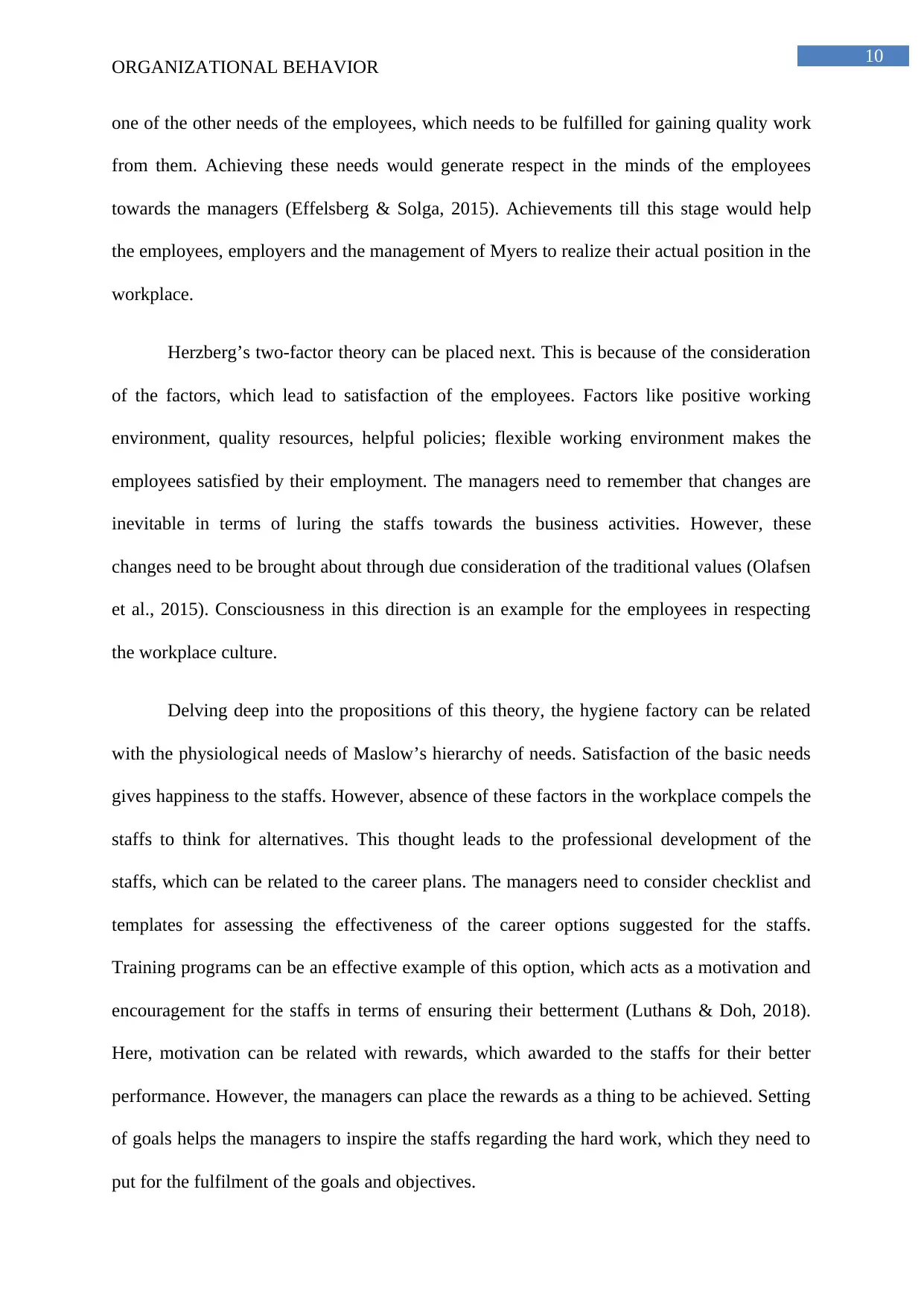
10
ORGANIZATIONAL BEHAVIOR
one of the other needs of the employees, which needs to be fulfilled for gaining quality work
from them. Achieving these needs would generate respect in the minds of the employees
towards the managers (Effelsberg & Solga, 2015). Achievements till this stage would help
the employees, employers and the management of Myers to realize their actual position in the
workplace.
Herzberg’s two-factor theory can be placed next. This is because of the consideration
of the factors, which lead to satisfaction of the employees. Factors like positive working
environment, quality resources, helpful policies; flexible working environment makes the
employees satisfied by their employment. The managers need to remember that changes are
inevitable in terms of luring the staffs towards the business activities. However, these
changes need to be brought about through due consideration of the traditional values (Olafsen
et al., 2015). Consciousness in this direction is an example for the employees in respecting
the workplace culture.
Delving deep into the propositions of this theory, the hygiene factory can be related
with the physiological needs of Maslow’s hierarchy of needs. Satisfaction of the basic needs
gives happiness to the staffs. However, absence of these factors in the workplace compels the
staffs to think for alternatives. This thought leads to the professional development of the
staffs, which can be related to the career plans. The managers need to consider checklist and
templates for assessing the effectiveness of the career options suggested for the staffs.
Training programs can be an effective example of this option, which acts as a motivation and
encouragement for the staffs in terms of ensuring their betterment (Luthans & Doh, 2018).
Here, motivation can be related with rewards, which awarded to the staffs for their better
performance. However, the managers can place the rewards as a thing to be achieved. Setting
of goals helps the managers to inspire the staffs regarding the hard work, which they need to
put for the fulfilment of the goals and objectives.
ORGANIZATIONAL BEHAVIOR
one of the other needs of the employees, which needs to be fulfilled for gaining quality work
from them. Achieving these needs would generate respect in the minds of the employees
towards the managers (Effelsberg & Solga, 2015). Achievements till this stage would help
the employees, employers and the management of Myers to realize their actual position in the
workplace.
Herzberg’s two-factor theory can be placed next. This is because of the consideration
of the factors, which lead to satisfaction of the employees. Factors like positive working
environment, quality resources, helpful policies; flexible working environment makes the
employees satisfied by their employment. The managers need to remember that changes are
inevitable in terms of luring the staffs towards the business activities. However, these
changes need to be brought about through due consideration of the traditional values (Olafsen
et al., 2015). Consciousness in this direction is an example for the employees in respecting
the workplace culture.
Delving deep into the propositions of this theory, the hygiene factory can be related
with the physiological needs of Maslow’s hierarchy of needs. Satisfaction of the basic needs
gives happiness to the staffs. However, absence of these factors in the workplace compels the
staffs to think for alternatives. This thought leads to the professional development of the
staffs, which can be related to the career plans. The managers need to consider checklist and
templates for assessing the effectiveness of the career options suggested for the staffs.
Training programs can be an effective example of this option, which acts as a motivation and
encouragement for the staffs in terms of ensuring their betterment (Luthans & Doh, 2018).
Here, motivation can be related with rewards, which awarded to the staffs for their better
performance. However, the managers can place the rewards as a thing to be achieved. Setting
of goals helps the managers to inspire the staffs regarding the hard work, which they need to
put for the fulfilment of the goals and objectives.
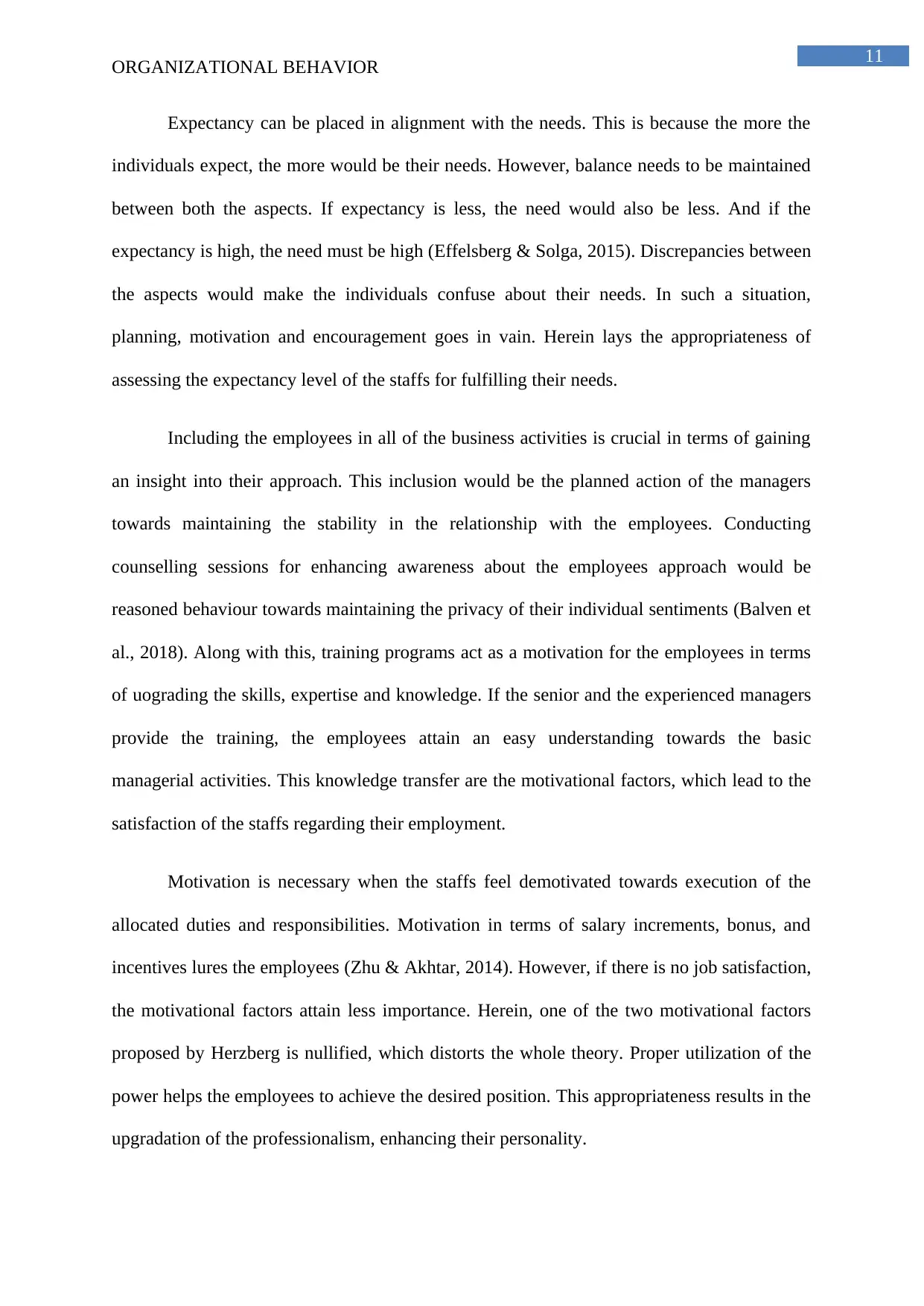
11
ORGANIZATIONAL BEHAVIOR
Expectancy can be placed in alignment with the needs. This is because the more the
individuals expect, the more would be their needs. However, balance needs to be maintained
between both the aspects. If expectancy is less, the need would also be less. And if the
expectancy is high, the need must be high (Effelsberg & Solga, 2015). Discrepancies between
the aspects would make the individuals confuse about their needs. In such a situation,
planning, motivation and encouragement goes in vain. Herein lays the appropriateness of
assessing the expectancy level of the staffs for fulfilling their needs.
Including the employees in all of the business activities is crucial in terms of gaining
an insight into their approach. This inclusion would be the planned action of the managers
towards maintaining the stability in the relationship with the employees. Conducting
counselling sessions for enhancing awareness about the employees approach would be
reasoned behaviour towards maintaining the privacy of their individual sentiments (Balven et
al., 2018). Along with this, training programs act as a motivation for the employees in terms
of uograding the skills, expertise and knowledge. If the senior and the experienced managers
provide the training, the employees attain an easy understanding towards the basic
managerial activities. This knowledge transfer are the motivational factors, which lead to the
satisfaction of the staffs regarding their employment.
Motivation is necessary when the staffs feel demotivated towards execution of the
allocated duties and responsibilities. Motivation in terms of salary increments, bonus, and
incentives lures the employees (Zhu & Akhtar, 2014). However, if there is no job satisfaction,
the motivational factors attain less importance. Herein, one of the two motivational factors
proposed by Herzberg is nullified, which distorts the whole theory. Proper utilization of the
power helps the employees to achieve the desired position. This appropriateness results in the
upgradation of the professionalism, enhancing their personality.
ORGANIZATIONAL BEHAVIOR
Expectancy can be placed in alignment with the needs. This is because the more the
individuals expect, the more would be their needs. However, balance needs to be maintained
between both the aspects. If expectancy is less, the need would also be less. And if the
expectancy is high, the need must be high (Effelsberg & Solga, 2015). Discrepancies between
the aspects would make the individuals confuse about their needs. In such a situation,
planning, motivation and encouragement goes in vain. Herein lays the appropriateness of
assessing the expectancy level of the staffs for fulfilling their needs.
Including the employees in all of the business activities is crucial in terms of gaining
an insight into their approach. This inclusion would be the planned action of the managers
towards maintaining the stability in the relationship with the employees. Conducting
counselling sessions for enhancing awareness about the employees approach would be
reasoned behaviour towards maintaining the privacy of their individual sentiments (Balven et
al., 2018). Along with this, training programs act as a motivation for the employees in terms
of uograding the skills, expertise and knowledge. If the senior and the experienced managers
provide the training, the employees attain an easy understanding towards the basic
managerial activities. This knowledge transfer are the motivational factors, which lead to the
satisfaction of the staffs regarding their employment.
Motivation is necessary when the staffs feel demotivated towards execution of the
allocated duties and responsibilities. Motivation in terms of salary increments, bonus, and
incentives lures the employees (Zhu & Akhtar, 2014). However, if there is no job satisfaction,
the motivational factors attain less importance. Herein, one of the two motivational factors
proposed by Herzberg is nullified, which distorts the whole theory. Proper utilization of the
power helps the employees to achieve the desired position. This appropriateness results in the
upgradation of the professionalism, enhancing their personality.
⊘ This is a preview!⊘
Do you want full access?
Subscribe today to unlock all pages.

Trusted by 1+ million students worldwide
1 out of 16
Related Documents
Your All-in-One AI-Powered Toolkit for Academic Success.
+13062052269
info@desklib.com
Available 24*7 on WhatsApp / Email
![[object Object]](/_next/static/media/star-bottom.7253800d.svg)
Unlock your academic potential
Copyright © 2020–2025 A2Z Services. All Rights Reserved. Developed and managed by ZUCOL.





